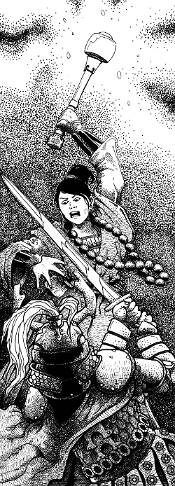Actions and Movement

In Dungeons of Olde, time and distance outside of combat are controlled and narrated by the gamemaster, following common sense and guidelines in the gamemasters' section of these rules.
In combat, the game is played with miniatures on a square or hex grid. The map scale is either 5 feet per space, or 2 meters per space, whichever your group prefers. Time is measured in Turns, Phases and Rounds, which are brief but somewhat flexible units.
Turns and Phases
Each turn is made up of an action phase and a reset phase. All movement and other actions are made during the action phase, which is broken up into a variable number of rounds. The reset phase is an accounting step, in which temporary conditions are resolved and persistent conditions are updated.
Reset Phase
Combat always begins and ends with a reset phase. During the reset phase, the following steps are taken, in order:
- Apply any per turn effects, such as poison or bleeding.
- Remove any temporary conditions and adjustments (which end at the conclusion of the turn in which they were imposed).
- Roll to remove any persistent conditions (which end only if the character succeeds on the necessary Check roll).
- Recover 1 Mana Point or 1 Faith Point, player's choice.
-
Set action points (AP) and free steps for the coming action phase.
- Left-over action points and/or free steps from the preceeding action phase are lost
- Roll one Finesse die for action points, and apply any adjustments
- Surprised characters receive exactly 1 action point in the first reset phase of a combat; afterwards, they roll for AP normally
- All characters receive a single free steps move each turn
- The current turn ends, and play proceeds to the action phase of the next turn.
Action Phase
The action phase is divided into a series of rounds, in which each character has one opportunity to act by expending action points, according to the following rules:
- In each round, characters act in descending order of current action points.
- Once per turn, a character may take free steps.
- The free step distance for medium-sized characters (humans, elves, orcs) is one or two spaces, which must be taken at once.
- The free step for small-sized characters (halflings, dwarves, goblins) is one space.
- free steps do not cost action points to use.
- Free steps may be taken in the same round as a normal movement and/or action, but they must be taken before any other movement or action in that round.
- A character doesn't have to spend action points in the round he uses his free steps, but a character must have AP remaining in order to use his free steps.
- A character may take his free steps before an Only action, either in an earlier round, or before the Only action in the same round.
- Free steps remaining at the end of the turn are lost.
- In a single round, a character may spend a total of no more than 3 action points to perform one movement and/or one action. Remaining AP are carried over into the next round of the current action phase.
- action points are marked off the character sheet as they are spent.
- If a character has only 1 or 2 action points to spend in a turn, he may spend all of his AP for the turn to take an Only action. A character may not perform any other movement or action, other than free steps, in a turn in which he takes an Only action.
- When a character has expended all of his action points for the current turn, he may take no more actions until the next turn.
- Certain movements and actions may apply temporary adjustments to a character's attributes, especially Defense.
- A character may pass his opportunity to act in the current round, saving his action points until a subsequent round.
- The action phase ends when every character in the combat has either:
- Expended all of his action points, and has 0 AP remaining, or
- Has passed on his opportunity to act in the current round.
- After the conclusion of the action phase, play proceeds to the reset phase for the current turn.
| Core Movement Table | |
|---|---|
| Movement | AP Cost |
| Step — Move up to 3 spaces per round at 1 AP/space | 1 per space |
| Climb — Move up or down one level (10' or 3 meters) by stairs or ladder | 2 |
| Drop — Move to a sitting, kneeling, or prone position; May be followed by an Action | 1 |
| Rise — Stand from a sitting, kneeling, or prone position; May be followed by an Action | 2/Only |
| Leap — Make a long or high jump according to the rules for the Leap skill | 1 |
| Core Actions Table | |
|---|---|
| Action | AP Cost |
| Attack — Melee or Ranged Attack | 2 |
| Shield Block — Melee only; Temporary +2 to Defense; Requires equipped shield and Journeyman Shield skill | 2 |
| Cast Spell — Cast a known magical spell or divine blessing | 2 |
| Use item or device — Use a magical or technological device to cast a spell-like effect; includes potions and scrolls | 3/Only |
| Administer First Aid — Stop an ally's bleeding or dying; Requires successful Healing Check (see Healing rules) | 3/Only |
| Recover — Rest and recover 2 Mana or Faith Points | 3/Only |
| Flop — Hastily throw self to sitting, kneeling or prone position; May be used after any movement | 0 |